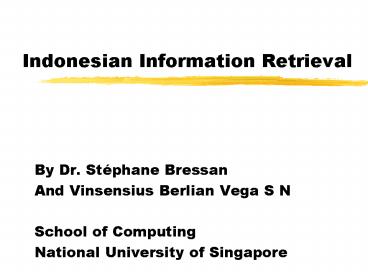Indonesian Information Retrieval PowerPoint PPT Presentation
1 / 26
Title: Indonesian Information Retrieval
1
Indonesian Information Retrieval
- By Dr. Stéphane Bressan
- And Vinsensius Berlian Vega S N
- School of Computing
- National University of Singapore
2
THE INTERNET
3
Objective
- To build a search engine dedicated to the assist
the Indonesian speaker - Indexing the Indonesian Web
- Queries in Indonesian
- Effective and efficient retrieval of Indonesian
Web documents
4
Search Engine Architecture
World Wide Web
URL Indexer
url request
(url, document)
document
(index keywords, url)
Data Storage
url
Index keywords
keywords
search engine
url
5
Retrieval Model
- Vector Space Model
- Documents and Queries are represented as vectors
in terms-dimensional-space - Similarity Measure and Ranking System used is
Normalized Weighted Cosine
6
Performance measure
- Recall/Precision
- Recall Fraction of relevant document retrieved
- Precision Fraction of relevant retrieved
document
Relevant Retrieved-Docs Ra
Retrieved Docs A
Relevant Docs R
7
Specific Issues
- Segmentation
- Stemming
- Language Identification
8
Segmentation
- Character set recognized
- Roman Alphabets
- No diacritics (e.g. è, é, or ä) in Indonesian,
but might need to include some, as foreign terms
might be absorbed unchanged (e.g. café) - dash (-), as it is used in writing plurals (e.g.
mobilcar, mobil-mobilcars), compound words
(e.g. tanda-tangan), and affixed
foreign/abbreviated terms (e.g. di-email, NEM-nya)
9
Segmentation
- Character set recognized (cont.)
- Digit 2 should receive special treatment as it
is common to use it to denote plurals (e.g.
mobil2), including affixed plurals (e.g.
mobil2-nya) and plurals of affixed-terms (e.g.
peternak2)
10
Stemming
- Indonesian Language is morphologically rich, i.e.
affixes are heavily used - Examples of affixes cars, government, reading
- All of the known Indonesian stemmers are
dictionary based - The challenge is to build an effective
non-dictionary based stemmer
11
Stemming
- Affixes Could appear as
- prefixes (e.g. berbicara)
- suffixes (e.g. peranan)
- infix (e.g. gembunggt gelembung)
- circumfix (e.g. memperbaiki)
- Letters might change due to affixes (e.g.
peperintah gt pemerintah) - Forms inflections (e.g. pukul vs. dipukul) and
derivations (e.g. perintah vs. pemerintah) - Inflections grammatical variant (e.g. due to
gender, time) - Derivations semantic variant (i.e. change in
meaning)
12
Stemming
- Morphologically rich, but most of them play the
derivational function gt stemming might not be as
crucial as other morphologically rich language
(e.g. Slovene Popovic92, French) - Might be applied iteratively (e.g. memperbaiki
(two prefixes and a suffix)) - The set of affixes is growing Kridalaksana89
(e.g. buatin), which especially apparent in
colloquial writing style and day-to-day
conversation
13
Language Identification
- Need to be able to effectively separate
Indonesian and non-Indonesian documents
14
Current Progress and Results
- Segmentation
- Stemming
- Language Identification
15
Current Progress and Results
- Segmentation
- A formal segmentation rule specified in form of
EBNF rules has been developed
16
Current Progress and Results
- Stemming Algorithms
- Implemented two non-dictionary-based stemmers in
form of Definite Clause Grammar using Prolog
17
Current Progress and Results
- We propose a language distinction (as opposed to
language distinction) technique that could
identify whether a document is written in
Indonesian given only Indonesian samples
(Positive Only Learning)
()
?
Training documents
-
Learning Algorithm
18
Trigrams
- Our technique is based on frequency of trigrams
- Trigrams are three-character substrings of a word
e.g. trigrams of hello are hel, ell, and
llo
19
Positive Only Learning
- Algorithm
if
gtq
otherwise
hx(d) hypothesis that document d is written in
language x fi,d frequency of trigram i in
document d wi weight associated with
trigram I (from the training set) q some
threshold
20
Positive Only Learning
21
Positive Only Learning
- Experimental results
22
Continuous Learning
- Given the high performance of the method, can the
algorithm trust its own decision to learn more? - Would it then be able to adapt to changes in
language trends ?
23
Continuous Learning
- The idea is to treat new documents that are
judged to be Indonesian as new samples
(Continuous Learning)
()
?
Training documents
-
24
Experimental Results
25
Conclusion
- The Jungle is Neutral, F. S. Chapman
The Web is neutral, S. F. Bressan
26
Conclusion
- We must be proactive in the usage and promotion
of our languages, and in the sharing and
development of our cultures. - Computer scientists must design and build tools
that cater for the cultural specificities

